|
Charting Tools
Analyzing Charts with Charting Tools
Introduction
Track ‘n Trade
5.0 has a complete set of charting tools that enable the futures trader
to apply concepts from technical analysis to their charting. Take a look
at some of the technical analysis formations and trends in this chapter
and see how to apply these concepts in trading with Track ‘n Trade 5.0
charting tools.
Crosshair Tool

The first tool
in the Charting toolbar is the Crosshair tool. This tool is helpful when
lining up your technical indicators and recurring price patterns. Click
the Crosshair button and position the crosshair on your chart and click
your mouse. The crosshair draws a line vertically and horizontally on
the chart. To help place the crosshair line on a specific value, the
cursor price is displayed on the vertical line of the crosshair.
Moving a
Crosshair
To select the
drawing, click on the center point of the crosshair and drag to the new
location. Release your mouse button to place. The tool is selected when
a box appears at the center point.
Deleting a
Crosshair Drawing
There are two
ways to delete the Crosshair tool. If your crosshair is selected (you’ve
clicked on it and the box appears at the center point), you can press
the Del (Delete) key on your keyboard. You can also place your mouse
cursor over the crosshair and right-click. In the drop-down menu, select
"Delete."
If you only want
to delete the horizontal or vertical line of the crosshair, select the
crosshair by clicking on it and view the preferences in the control
panel. Select or deselect "Show Horizontal (Vertical) Line." A check
will appear in front of the item when it is selected.
Preferences
Select the
crosshair by clicking on it. The properties will appear in the
preferences section of your control panel.
Restore
Settings: TNT Default will change your settings back to the original
software settings. My Default will change current settings to your
personalized default settings. Apply To All Charts will apply your
selected settings on all open charts. Save As My Default will save your
current personal settings.
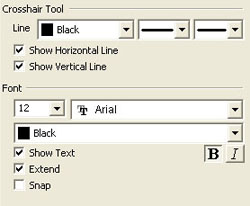 |
Crosshair
Tool: You can choose the color, line style, and line thickness of
your crosshair. Deselect Show Horizontal Line or Show Vertical
Line to hide your lines.
Font: Select
the font, size, and color of the text. You can also choose to bold or
italicize your text. Select the checkbox next to Show Text to
hide or show your text on the chart.
Select Extend
if you would like your line to extend into the Indicator window. Select
Snap if you want your crosshair to snap to price bars when moved.
|
Example of the Crosshair Tool
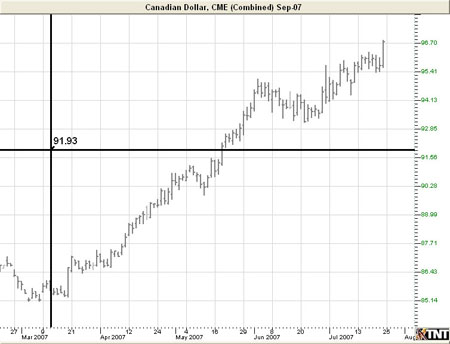
Back To Top
The remaining
technical tools are used to identify technical analysis formations and
trends. Take a look at the different patterns available then read about
how to use each of the technical tools and apply the technical concepts
learned.
|
Support
and Resistance - Technical Analysis
Markets have a tendency to move in troughs and peaks or, more
appropriately, "Support and Resistance."
|
|
 |
Support
These
Troughs are called support, indicating that support is level.
This shows that buying interest is strong enough to overcome
selling pressure. A decrease in price is reversed and prices
rise once again. Typically, a support level is identified by a
previous set of lows.
|
|
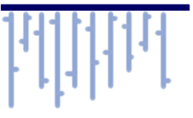 |
Resistance
Resistance is essentially the opposite of support. Resistance is
defined as a horizontal ceiling where the pressure to sell is
greater than the pressure to buy. An increase in price is
reversed and prices revert downward. Typically, support can be
located on a chart by a previous set of highs.
|
Line Tool

To draw a
support or resistance line, also referred to as a trend, use the Line
tool. Select the Line tool from your Charting toolbar. Click on your
chart where you want the line to begin. Hold down the mouse button and
move to the position you want your line to end. Release mouse button to
place.
Resizing the Line
Select the line
drawing by clicking on it. The line is selected when boxes appear at the
ends of the line. Click on one of the boxes and drag it to the desired
length. Release the mouse button to place the end point of the line.
Moving the Line
Select the line
drawing by clicking on it. Click on the line, not an end box, and drag
the line to the new location. Release the mouse button to place.
Deleting the
Line
Select the line
drawing by clicking on it. Press the Del (Delete) key on your keyboard.
You can also right-click the line drawing and select "Delete" from the
dropdown menu.
Preferences
Select the line
drawing by clicking on it. The properties will appear in the preferences
section of your control panel.
Restore
Settings: TNT Default will change your settings back to the original
software settings. My Default will change current settings to your
personalized default settings. Apply To All Charts will apply your
selected settings on all open charts. Save As My Default will save your
current personal settings.
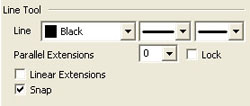 |
Line
Tool: You can choose the color, line style, and line thickness of
your line.
Parallel
Extensions: Select from the dropdown menu how many lines you would
like to add. Deselect Lock if you want to be able to move them
independently.
Select Linear
Extensions to extend your line to the edge of your chart window.
Select Snap if you want your crosshair to snap to price bars when
moved.
|
Example of the Line Tool
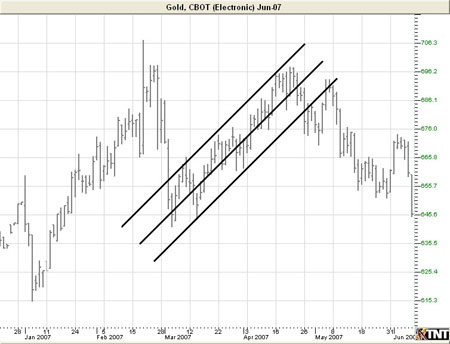
Back To Top
Multi-Line Tool

Some contracts
will have a continuous line, or trend, of alternating support and
resistance. To illustrate these multi-lines, select the Multi-Line tool
from your Charting toolbar. Click on the chart where you want your line
to start. Move your mouse to the next point on your multi-line and click
to place. Repeat this until the last point. When placing the last point
on the multi-line, right-click to finish.
Resizing the
Multi-Line
Select the
multi-line drawing by clicking on it. You will know the multi-line is
selected when boxes appear at the ends of the multi-line. Click on a box
and drag it to your desired length. Release the mouse button to place.
Moving the
Multi-Line
Select the
multi-line drawing by clicking on it. Click on the multi-line, not a
box, and drag it to the new location. Release mouse button to place.
Deleting the
Multi-Line
Select the
multi-line drawing by clicking on it. Press the Del (Delete) key on your
keyboard. You can also right-click the multi-line drawing and select
"Delete" from the dropdown menu.
Preferences
Select the line
drawing by clicking on it. The properties will appear in the preferences
section of your control panel.
Restore
Settings: TNT Default will change your settings back to the original
software settings. My Default will change current settings to your
personalized default settings. Apply To All Charts will apply your
selected settings on all open charts. Save As My Default will save your
current personal settings.
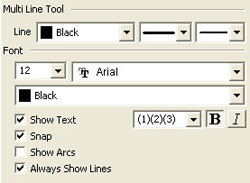 |
Multi
Line Tool: You can choose the color, line style, and line thickness
of your lines.
Font: Select
the font, size, and color of the text. You can also choose to see
numbers or letters. Select Show Text to hide or show your text on
the chart.
Select Snap
to have your lines snap to price bars when moved. Select if you would
like to Show Arcs or Always Show Lines on your drawing.
|
Example of Multi-Line Tool

Back To Top
|
123 Formations - Technical Analysis
The
123 formation anticipates a change in trend. There are both top
and bottom formations.
|
|
 |
123
Top Formation
The
123 top formation anticipates a change in trend, from up to
down, on a break below the number two point. This formation is
easily identified because the number 1 point is the annual price
high for the contract.
To trade
a 123 top formation, place a sell order on a break down
past the 2 point. Then place a stop loss order just above the 1
point (an industry standard) or just above the 3 point (a more
conservative stop loss placement).
|
|
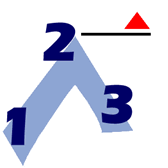 |
123
Bottom Formation
The 123 bottom formation anticipates a change in
trend from down to up on a break above the number 2 point. A 123
bottom formation is easily identified because the number 1 point
is the annual price low.
To trade a 123 bottom
formation, place a buy order just above the 2 point. Then
place a stop loss order just below the 1 point (an industry
standard) or just below the 3 point (a more conservative
placement). |
123 Tool

Use the 123 tool
to chart both top and bottom formations. To draw a 123 formation, select
the 123 tool from your Charting toolbar. Position the mouse pointer over
the spot you would like to place the 1 point and click to place. Move to
the 2 point and click to place. Move to the 3 point and click to place.
Resizing the 123
Drawing
Select the 123
drawing by clicking on it. You will know the 123 drawing is selected
when boxes appear on the corners. Click on a box and drag it to your
desired length. Release the mouse button to place.
Moving the 123
Drawing
Select the 123
drawing by clicking on it. The drawing is selected when boxes appear at
the 1, 2, and 3 end points. Drag to the new location and release the
mouse button to place.
Deleting the 123
Drawing
Select the 123
drawing by clicking on it. Press the Del (Delete) key on your keyboard.
You can also right-click the 123 drawing and select "Delete" from the
drop-down menu.
Preferences
Select the 123
drawing by clicking on it. The properties will show up in the
preferences section of your control panel.
Restore
Settings: TNT Default will change your settings back to the original
software settings. My Default will change current settings to your
personalized default settings. Apply To All Charts will apply your
selected settings on all open charts. Save As My Default will save your
current personal settings.
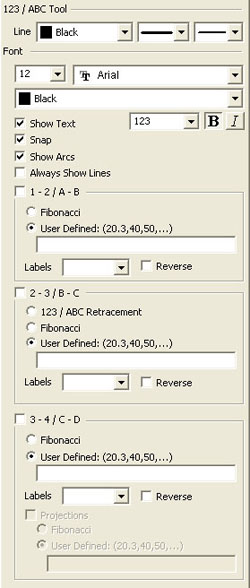 |
123
/ ABC Tool: You can choose the color, line style, and line thickness
of your lines.
Font: Select
the font, size, and color of the text. You can also choose to see
numbers or letters. Select Show Text to hide or show your text on
the chart.
Select Snap
to have your lines snap to price bars when moved. Select if you would
like to Show Arcs or Always Show Lines on your drawing.
1-2/A-B,
2-3/B-C: Select if you would like to see Fibonacci
Retracements on either line or type in your own values in User
Defined. Choose from the Labels dropdown menu to view the
marks as price, percent, or both.
3-4/C-D:
Select if you would like to see a third prediction line after point C.
You can view Fibonacci Retracements on this line or type in your
own values in User Defined. Choose from the Labels
dropdown menu to view the marks as price, percent, or both.
Select
Projections to view a projected line extended from the C-D line. You
can view Fibonacci Retracements on this line or type in your own
values in User Defined.
|
Example of the 123 Top and Bottom
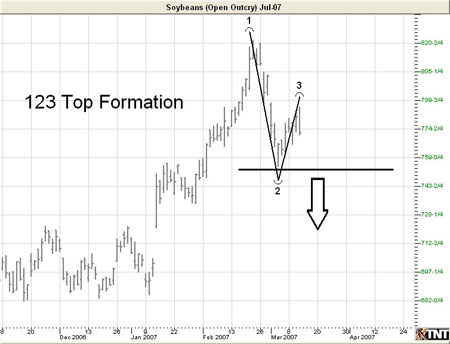
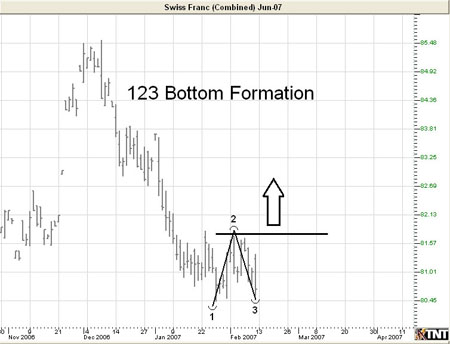
Back To Top
|
Head & Shoulders Formations - Technical
Analysis
This
formation can appear anywhere in the chart and is made up of the
Head, Left Shoulder, and Right Shoulder. There are both top and
bottom formations. |
|
 |
Head &
Shoulders Top Formation
In this
formation, the middle peak, the Head (H), is higher than either
shoulder (LS, RS). This formation anticipates a drop in price
below the Neckline (shown by the red arrow).
To trade
a Head & Shoulders top formation, place a sell order on the
break of the Neckline. Your stop loss order should then be
placed just above the Head. The stop loss order can also be
placed above the Right Shoulder as a more conservative point. |
|
 |
Head &
Shoulders Bottom Formation
This
formation is an inverted version of the Head & Shoulders top
formation. A Head & Shoulders bottom anticipates a rise in price
above the Neckline.
To trade
a Head & Shoulders bottom formation, place a buy order on the
break up from the Neckline. Then place a stop loss order just
below the Head. The stop loss order can also be placed below the
Right Shoulder as a more conservative point. |
Head & Shoulders Tool

To identify a
H&S top or bottom formation, use the Head & Shoulder tool. Select the
Head & Shoulders tool from your Charting toolbar. Position the mouse
pointer where you would like to place the Left Shoulder (LS) point and
click to place. Move to the valley point between the LS and the Head (H)
and click to place. Move to the H point and click to place. Move to the
valley point between the H and Right Shoulder (RS) and click to place.
Move to the RS point and click to place.
Resizing the
Head & Shoulders Drawing
Select the H&S
drawing by clicking on it. You will know the drawing is selected when
boxes appear on the corners. Click on a box and drag it to your desired
length. Release the mouse button to place.
Moving the Head
& Shoulders Drawing
Select the H&S
drawing by clicking on it. The tool is selected when boxes appear at the
LS, H, and RS end points. Drag to the new location and release the mouse
button to place.
Deleting the Head & Shoulders Drawing
Select the H&S
drawing by clicking on it. Press the Del (Delete) key on your keyboard.
You can also right-click the drawing and select "Delete" from the
dropdown menu.
Preferences
Select the H&S
drawing by clicking on it. The properties will appear in the preferences
section of your control panel.
Restore
Settings: TNT Default will change your settings back to the original
software settings. My Default will change current settings to your
personalized default settings. Apply To All Charts will apply your
selected settings on all open charts. Save As My Default will save your
current personal settings.
 |
Head
and Shoulders Tool: You can choose the color, line style, and line
thickness of your lines.
Font: Select
the font, size, and color of the text. Select Show Text to hide
or show your text on the chart.
Select Snap
to have your lines snap to price bars when moved. Select if you would
like to Show Arcs or Always Show Lines on your drawing.
|
Example of Head & Shoulders Top and Bottom
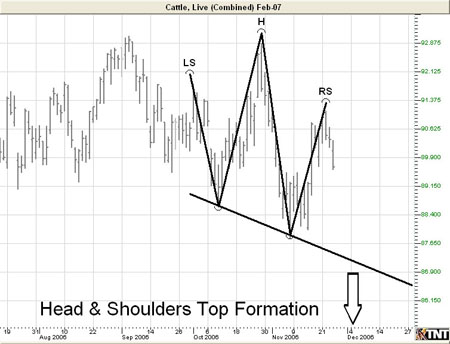
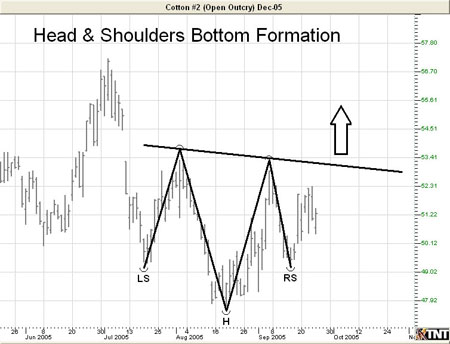
Back To Top
|
Channels - Technical Analysis
A
trend channel consists of a section of price bars that are
between parallel support and resistance lines. There are three
types of channels: the Narrow Sideways Channel, the Inclining
Channel, and the Declining Channel. |
|
Narrow
Sideways Channel
A Narrow
Sideways channel is a formation that features both resistance
and support with a sideways movement. Support forms the low
price bar, while resistance provides the price ceiling.
To trade
a Narrow Sideways channel, place an order to buy on a
break up and out of the channel, or sell on a break down
and out of the channel.
|
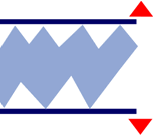 |
|
Inclining Channel
The
Inclining channel is a formation with parallel price barriers
along both the price ceiling and floor. Unlike the Narrow
Sideways channel, the Inclining channel has an increase in both
the price ceiling and price floor. The breaking of the bottom
trend line on this formation shows a change in trend from
bullish to bearish.
To trade
an Inclining channel, place an order to sell on the break
down and out of the channel.
|
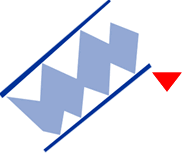 |
|
Declining Channel
The
Declining channel is the exact opposite of the Inclining channel
formation. The Declining channel has a decrease in both the
price ceiling and price floor. The breaking of the top trend
line on this formation shows a change in trend from bearish to
bullish.
To trade a Declining
channel, place an order to buy on the break up and out of
the channel.
|
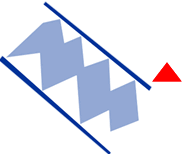 |
Narrow
Sideways Channel Tool

Illustrate a
Narrow Sideways channel in a chart by selecting the Narrow Sideways
Channel tool from your Charting toolbar. Position the mouse pointer
where you would like to place the to top-left point of the channel and
click. Continue to hold down the mouse and drag it to the bottom-right
point of your channel. Release the mouse button to place.
Resizing the
Narrow Sideways Channel
Select the
Narrow Sideways channel by clicking on it. You will know the channel is
selected when boxes appear on the corners. Click on a box and drag it to
your desired location. Release the mouse button to place.
Moving the
Narrow Sideways Channel
Select the
Narrow Sideways channel by clicking on it. Drag to the new location and
release the mouse button to place.
Deleting the
Narrow Sideways Channel
Select the
Narrow Sideways channel by clicking on it. Press the Del (Delete) key on
your keyboard. You can also right-click the channel and select "Delete"
from the dropdown menu.
Preferences
Select the
Narrow Sideways channel by clicking on it. The properties will appear in
the preferences section of your control panel.
Restore
Settings: TNT Default will change your settings back to the original
software settings. My Default will change current settings to your
personalized default settings. Apply To All Charts will apply your
selected settings on all open charts. Save As My Default will save your
current personal settings.
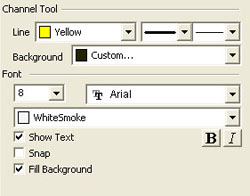 |
Channel
Tool: You can choose the color, line style, and line thickness of
your lines, as well as the background color. (To make the background
transparent, deselect Fill Background at the bottom of your
preferences.)
Font: Select
the font, size, and color of the text. Select Show Text to hide
or show your text on the chart.
Select Snap
to have your lines snap to price bars when moved.
|
Back To Top
Inclining/Declining Channel Tool

Identify an
Inclining or Declining Channel by selecting the Inclining/Declining
Channel tool from your Charting toolbar. Position the mouse pointer
where you would like to place the top-left point of the channel and
click. Move to the bottom-left point and click again. Move to the
bottom-right point and click again. Position the mouse pointer where you
would like to place the top-right final point of your channel and click
to place.
Resizing the
Inclining/Declining Channel
Select the
channel by clicking on it. You will know the channel is selected when
boxes appear at the corners. Click on a box and drag it to your desired
location. Release the mouse button to place.
Moving the
Inclining/Declining Channel
Select the
channel by clicking on it. Drag to the new location and release the
mouse button to place.
Deleting the
Inclining/Declining Channel
Select the
channel by clicking on it. Press the Del (Delete) key on your keyboard.
You can also right-click the channel and select "Delete" from the
dropdown menu.
Preferences
Select the
channel by clicking on it. The properties will appear in the preferences
section of your control panel.
Restore
Settings: TNT Default will change your settings back to the original
software settings. My Default will change current settings to your
personalized default settings. Apply To All Charts will apply your
selected settings on all open charts. Save As My Default will save your
current personal settings.
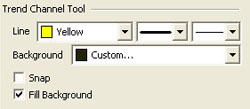 |
Trend
Channel Tool: You can choose the color, line style, and line
thickness of your lines, as well as the background color. (To make the
background transparent, deselect Fill Background at the bottom of
your preferences.)
Select Snap
to have your lines snap to price bars when moved.
|
Example of Inclining/Declining Channels

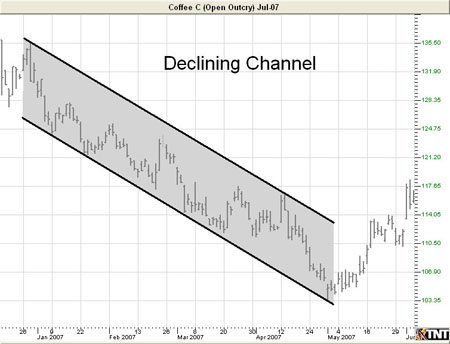
Back To Top
|
50% Retracements - Technical Analysis
Markets move in waves called retracements. These waves have up
and down trends. |
|
Up Trend
(Bull Market)
In the
diagram to the right, the market is in an overall uptrend;
however, within the uptrend are small areas where the market
falls back, or "retraces," each time establishing a new higher
high.
|
 |
|
Down
Trend (Bear Market)
This
chart shows how the market made lower highs and lower lows,
while still maintaining the overall down trend. Each retracement
was about 50% of the last move before they continued on in their
original direction.
Markets have a tendency to retrace half of the last move in
overall long-term trends. |
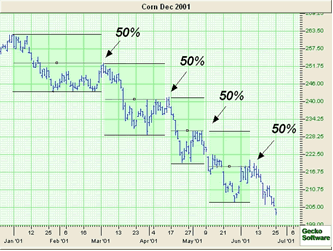 |
N% Tool

You can measure
a retracement by selecting the N% tool from your Charting toolbar.
Position the mouse pointer where you would like to place the top-left
point of the channel and click. Continue to hold down the mouse button
and drag to the bottom-right point of the channel. Release mouse button
to place. The default on this charting tool is 50%. (For more
information on retracements, see Fibonacci Time Zone and Fan tools in
the Advanced Charting Tools
section.)
Resizing the N%
Channel
Select the
channel by clicking on it. You will know the channel is selected when
boxes appear on the corners. Click on a box and drag it to your desired
location. Release the mouse button to place.
Moving the N%
Channel
Select the
channel by clicking on it. Drag to the new location and release the
mouse button to place.
Moving the %
Line in the N% Channel
Select the
channel by clicking on it. Notice the box in the center of the middle
line. Click and drag the box to move the line. As you change the
position of the percentage line, the percentage value to the left will
change as well.
Deleting the N%
Channel
Select the
channel by clicking on it. Press the Del (Delete) key on your keyboard.
You can also right-click the channel and select "Delete" from the
dropdown menu.
Preferences
Select the
channel by clicking on it. The properties will appear in the preferences
section of your control panel.
Restore
Settings: TNT Default will change your settings back to the original
software settings. My Default will change current settings to your
personalized default settings. Apply To All Charts will apply your
selected settings on all open charts. Save As My Default will save your
current personal settings.
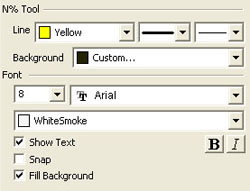 |
N%
Tool: You can choose the color, line style, and line thickness of
your lines, as well as the background color. (To make the background
transparent, deselect Fill Background at the bottom of your
preferences.)
Font: Select
the font, size, and color of the text. Select Show Text to hide
or show your text on the chart.
Select Snap
to have your lines snap to price bars when moved.
|
Back To Top
|
Wedges and Triangles - Technical
Analysis
The
wedge formation occurs when the slope of price bar highs and
lows consolidate to a point. The triangle formation occurs when
there is a pause in the current trend. |
|
Inclining Wedge
The
Inclining Wedge formation occurs when the slope of both lines is
up with the lower line being steeper then the higher one.
To trade
the Inclining Wedge, place a buy on a break up and out of
the wedge or a sell order on a break down and out of the
wedge. Inclining Wedges with a prior downtrend are anticipated
to break down and out, rather than up and out.
|
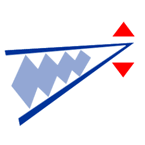 |
|
Declining Wedge
The
Declining Wedge formation occurs when the slope of both lines is
down, the top line being steeper then the lower one. This
formation is opposite the Inclining Wedge.
Trade
the Declining Wedge the same as the Inclining Wedge. Declining
Wedges with a prior uptrend are anticipated to break up and out,
rather than down and out.
|
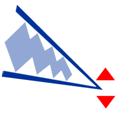 |
|
Symmetrical Triangle
A
Symmetrical Triangle is likely to resume the previous trend
after the pause forming the triangle. Notice the price bars form
a perfect symmetrical triangle shape.
To trade
a Symmetrical Triangle, place a buy order on a break up
and out of the triangle or a sell order on a break down
and out of the triangle.
|
 |
|
Non-Symmetrical Triangle
A
Non-Symmetrical Triangle is exactly the same as the Symmetrical
Triangle, except lacking symmetry. The formation resumes the
previous trend when a break occurs.
Trade a
Non-Symmetrical Triangle just as you would a Symmetrical
Triangle.
|
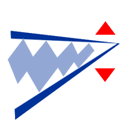 |
Wedge and
Triangle Tool

Identify any
type of wedge or triangle by selecting the Wedge tool from your Charting
toolbar. Position the mouse pointer where you would like to place the
top point of the triangle and click. Move to the bottom point of the
triangle and click again. Position the mouse pointer where you would
like to place the final point of the triangle and click to place.
Resizing the
Wedge/Triangle
Select the
drawing by clicking on it. You will know the drawing is selected when
boxes appear at the corners. Click on a box and drag it to your desired
location. Release the mouse button to place.
Moving the
Wedge/Triangle
Select the
drawing by clicking on it. Drag to the new location and release the
mouse button to place.
Deleting the
Wedge/Triangle
Select the
drawing by clicking on it. Press the Del (Delete) key on your keyboard.
You can also right-click the drawing and select "Delete" from the
dropdown menu.
Preferences
Select the
drawing by clicking on it. The properties will appear in the preferences
section of your control panel.
Restore
Settings: TNT Default will change your settings back to the original
software settings. My Default will change current settings to your
personalized default settings. Apply To All Charts will apply your
selected settings on all open charts. Save As My Default will save your
current personal settings.
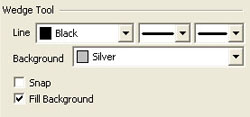 |
Wedge
Tool: You can choose the color, line style, and line thickness of
your lines, as well as the background color. (To make the background
transparent, deselect Fill Background at the bottom of your
preferences.)
Select Snap
to have your lines snap to price bars when moved.
|
Example of an Inclining and Declining Wedge

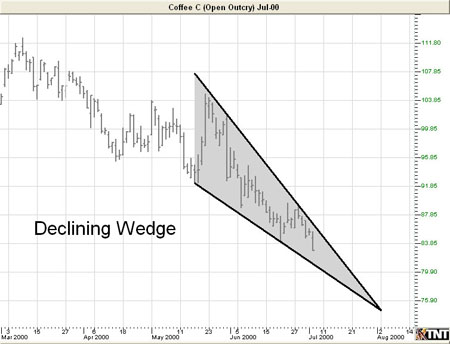
Example of a Symmetrical and Non-Symmetrical
Triangle
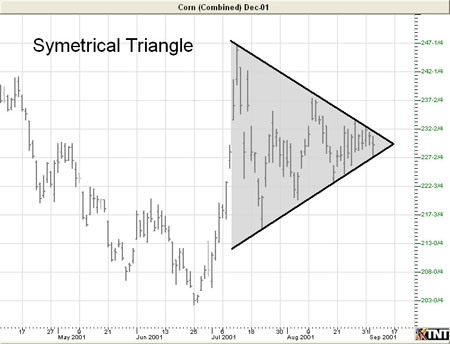
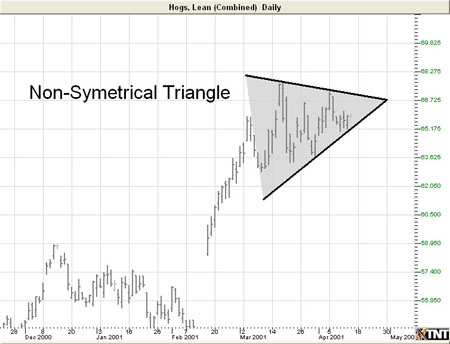
Back To Top
|
Trend Fan - Technical Analysis
Trend Fans are an extension of the regular trend line. They
accent simple trend line trading concepts by extending the
single trend line to multiple fan lines that give a better look
at a trend, its retracements, and market reversals. |
|
Trend
Fan
As a
trend moves up in scale, a chartist will draw a line across
price bar lows or, when a market is moving down, across the
price bar highs.
As the
market continues to make its retracement, we can draw another
trend line across the next level of support or resistance. The
line is support if the market is moving up and resistance if it
is moving down.
The last move of the
trend was resistance for the first trend line, and is now
support for the second trend line. The third trend line shows
that the market has made a solid retracement down past this
third fan line.
|
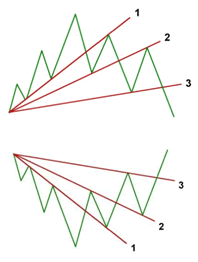 |
|
When the
market crosses the third fan line, it is considered to be
confirmation of market retracement. A market that was once
considered bullish is now bearish, or if bearish, would now be
considered bullish. When the markets price bars cross above or
below the third trend fan line, this is your signal and
confirmation that the market has shifted from bullish to
bearish, or bearish to bullish.
To trade
a Trend Fan, place an order to enter the market on the break out
past the third Trend Fan line.
|
Trend Fan Tool

Identify a trend
fan within a chart by selecting the Trend Fan tool from your Charting
toolbar. Position the mouse pointer where you would like to place the
main point of your trend fan. Move the mouse pointer to the end of the
first line and click. Add as many lines of your trend fan as you would
like. To place the last trend, position the mouse pointer at the end of
the last line and right-click to place.
Resizing the
Trend Fan
Select the
drawing by clicking on it. You will know the drawing is selected when
boxes appear at the ends of the lines. Click on a box and drag it to
your desired location. Release the mouse button to place.
Moving the Trend
Fan
Select the
drawing by clicking on it. Drag to the new location and release the
mouse button to place.
Deleting the
Trend Fan
Select the
drawing by clicking on it. Press the Del (Delete) key on your keyboard.
You can also right-click the drawing and select "Delete" from the
dropdown menu.
Preferences
Select the
drawing by clicking on it. The properties will appear in the preferences
section of your control panel.
Restore
Settings: TNT Default will change your settings back to the original
software settings. My Default will change current settings to your
personalized default settings. Apply To All Charts will apply your
selected settings on all open charts. Save As My Default will save your
current personal settings.
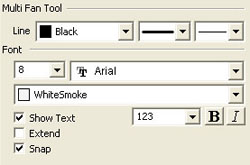 |
Multi
Fan Tool: You can choose the color, line style, and line thickness
of your lines.
Font: Select the
font, size, and color of the text. Select Show Text to hide or
show your text on the chart.
Select Extend
if you would like your lines to extend to the edges of your chart
window. Select Snap to have your lines snap to price bars when
moved.
|
Example of a Trend Fan
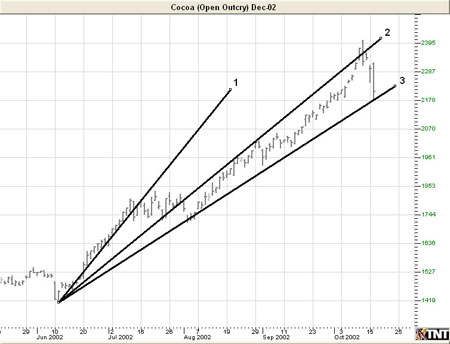
Back To Top
|